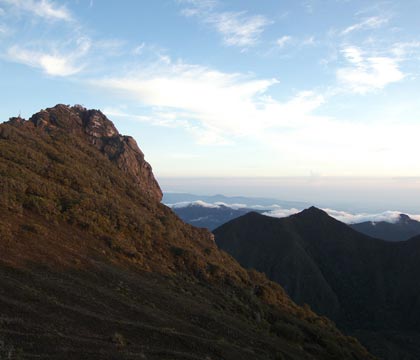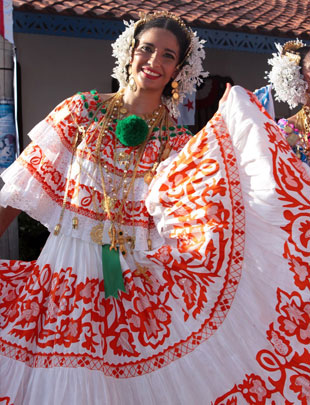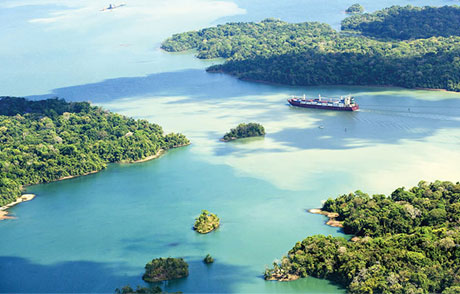Panama
Country statistics

Land area: 29,340 sq miles (75,991 sq km)
Total area: 30,193 sq miles (78,200 sq km)
Population (2011 est.): 3,510,045 (growth rate: 1.41%); birth rate: 19.17/1000; infant mortality rate: 11.32/1000; life expectancy: 77.96; density per sq miles: 115
Capital City: Panama City
Monetary unit: balboa; U.S. dollar
Languages: Spanish (official), English 14%, many bilingual
Ethnicity/race: mestizo 70%, Amerindian and mixed (West Indian) 14%, white 10%, Indian 6%
Religions: Roman Catholic 85%, Protestant 15%
Country introduction

Panama is a country located in the Central America region of North America, bordering both the Caribbean Sea and the North Pacific Ocean, between Colombia and Costa Rica.
The dominant feature of the country's landform is the central spine of mountains and hills that forms the continental divide. This divide is not a part of the mountains of North America and end near the Colombian border. The spine of the mountains is highly eroded due to the effects of nature over thousands of years. The divide of the mountain range is called the Cordillera de Talamanca. The mountain range between the Panama Canal and Costa Rica is called Cordillera Central.
The highest point in the country is the Volcan Baru (formerly known as the Volcan de Chiriqui), which rises to 3,475 m (11,401 ft). A nearly impenetrable jungle forms the Darien Gap between Panama and Colombia where Colombian guerrilla and drug dealers are operating with hostage-taking. This and forest protection movements create a break in the Pan-American Highway, which otherwise forms a complete road from Alaska to Patagonia.
Panama has the most accesable humid tropical forest in the world, its diverse national parks occupies 5 million acres and has the largest bio-diversity of forests of all the countries in Central America. It is home to many South American species as well as North American wildlife.
Nearly 500 rivers lace Panama's rugged landscape. Mostly unnavigable, many originate as swift highland streams, meander in valleys, and form coastal deltas. However, the Río Chagres located in Central Panama is one of the few wide rivers and a source of enormous hydroelectric power. The central part of the river is dammed by the Gatun Dam and forms Gatun Lake, an artificial lake that constitutes part of the Panama Canal. The Panama Canal created between 1907 and 1913 is a 77.1 km (48 miles) ship canal that connects the Atlantic Ocean (via the Caribbean Sea) to the Pacific Ocean. The canal cuts across the Isthmus of Panama and is a key conduit for international maritime trade. The Kampia and Madden Lakes (also filled with water from the Río Chagres) provide hydroelectricity for the area of the former Canal Zone.
Panama consists of two main island groups, both in the Caribbean. North-west of Panama are a group of islands called the Bocas del Toro Archipelago, which consists of 9 islands, 52 cays and some 200 tiny islets. Off the north coast of the Isthmus of Panama is another group of islands called the San Blas Archipelago, comprising approximately of 378 islands and cays, of which only 49 are inhabited and lie east of the Panama Canal.
The culture

Panama is a tropical paradise waiting to be seen, consisting of a culture that blends European, African, and Caribbean influences. It is full of adventure and wonder and has many different customs and traditions throughout the country waiting to be explored.
The impact of the Spanish is evident in the language, architecture, religion and music of Panama, however, in each of these areas, as well as many others, the Afro-Caribbean influence is also evident.
The official language of Panama is Spanish, although a variety of other languages are spoken and known by many of the residents, with English being a common language. Some of the popular dialects of the Indian Ethnic groups are Wounaan, Teribe, Embera, Kuna, and Ngohe-bugle. A stroll through the country will also allow other languages to be heard including Chinese, French, Arabic, and Hebrew.
Education is very important to the people of Panama as they hold the highest literacy rate in Central America. Statistics indicate that over 90% of the population is literate. Most speak and read English well, along with Spanish, Hebrew, Mandarin, and other languages. Amazingly, 95% of their students graduate from high school and most pursue college. Panama has many upscale colleges including five private Universities, one major Catholic University, and the University of Panama.
Due to the diverse cultures sharing space in Panama, the available cuisine can vary from the familiar to the very exotic. Breakfasts can include deep-fried corn tortillas, eggs, and coffee. There are also many fruits available throughout the country. For other meals, various cuts of meat, beans, yucca, plantains, and coconut rice can be found. An array of fresh seafood and tropical fruits such as mangos and coconuts can be found in the coastal areas. Some of the more common foods are empanadas (flour pastries filled with meat, potatoes, and cheese), sancocho (stew), tamales (meat filled corn dough wrapped in banana leaves), and carimanola (fried yucca with stuffed meat and boiled eggs). Also popular is ceviche; mixture of raw fish, conch, shrimp, cilantro, tomatoes, and onions marinated in lime juice. Ceviche has also become quite a popular dish in America and is served in many restaurants.
The traditional dress in Panama is called a Pollera, which dates back to 1815. It is worn on special occasions by most women or for those that can afford it. It is a beautiful, long, fluffy dress made of fine linen cloth. The pollera is sprinkled with many beautiful jewels, gold, and pearls. This dress can cost hundreds or even thousands of dollars to make and is passed down through generations.
Attractions & landmarks

As the capital and largest city, Panama City is one of Latin America's most dynamic cities. Located at the Pacific entrance of the Panama Canal, Panama City is the political and administrative center of the country. Panama City offers easy cosmopolitan living, a delightful combination of historic and ultra-modern. Panama Viejo was where the Spanish originally founded the city, and the ruins here are all that remains from battles fought with the English buccaneer, Henry Morgan in 1671. The Casco Viejo district is one of the country's best examples of Spanish colonial architecture. The historical buildings here were built by the Spanish once they relocated the city. The city is best known for being home to the architectural feat called The Panama Canal and is also very close to some of Central America's richest rainforests.
The Panama Canal is undoubtedly a main tourist attractions in Panama. Stretching from the Atlantic coast near the city of Colon down to the Pacific coast near Panama City, this famed waterway is an engineering feat. There is a Panama Canal Visitors Center at the Miraflores Locks where a museum can be found. The museum depicts the history of the canal covering all aspects related to the construction of the canal and the city, as well as hosting other exhibits. Many cruises to Panama feature a trip down the canal.
Visitors to Panama City can escape the urban drone by simply heading to the city's Metropolitan Park, which is among the more intriguing tourist attractions for Panama. It is the world's only rainforest found within the limits of a major city, and guided tours can be taken to learn all about the native flora and fauna. The adjacent Camino de Cruces National Park also has some great hiking trails that are suited for both beginners and advanced hikers.
Panama's natural beauty is hard to deny when trekking in the Darien Gap or in the San Blas Islands. Visitors to the pristine and highly underdeveloped Bocas del Toro Islands will be treated to great scuba diving and snorkeling, while those heading to the Chiriqui Highlands will find a list of great adventure travel tours to take advantage of. The Chiriqui Province city of Boquete is a major Panama adventure travel hub. Here visitors can take horseback riding, ATV exploring, white water rafting and volcano hiking in Boquete, and the nearby town of Volcan is also full of agencies offering regional adventure travel pursuits. Treks in the dangerous Darien Gap region are reserved for the most adventurous souls.